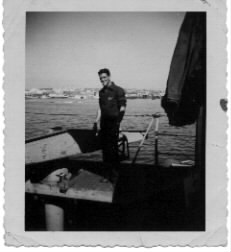After returning to my ship from leave I resumed my duties.
While on my first tour in Japan I had started "striking" for a torpedomans rating. In 1950 I was promoted to 3rd.class torpedoman.

On 1 April 1950,Cdr.W.S. Stewart assumed command of the Henderson. In June of 1950 the war had started in Korea and the Henderson was in drydock in San Francisco being refitted. After we left drydock we received orders to depart for Japan on August 5, 1950 and duty in the Korean waters.We armed all of our torpedos with warheads. it was very exciting ,we were going to war!.
Our duties in the Korean waters were patroling the coastline and escorting aircraft carriers launching airstrikes against enemy forces, a good part of this duty is what was called "plane guard detail",which was following in the carriers wake and in case one of our aircraft had to ditch in the ocean we would attempt to rescue the pilot.It was a very necessary duty but it could be very boring, as we had to remain on duty watch for hours at a time.
While we were at sea we stood 4 hour watch duty.,as a petty officer I was now qualified to stand helm watch and I really enjoyed this. We were constantly holding training exercises and one of these was anti-submarine warfare.This involved a lot of maneuvering at top speeds and as the helmsman my duty was responding to the duty officers course changes(in other words steering the ship).
The U.S.S. Henderson was in Yokosuka,Japan in Sept.of 1950 when she received orders to proceed to Sasebo,Japan.In Sasebo the crew loaded ammunition all night long and departed the next morning.As we exited Sasebo harbour we ran into typhoon Kezia with 90 knot winds and massive waves,we rode the storm out until shortly before we reached Inchon. Once we were at at sea, the commanding officer opened our sealed orders and read them over the public address system.
The orders called for us to proceed to the port of Inchon,Korea with 5 sister ships and to drop anchor and wait for the enemy to open fire on us so we could spot their gun enplacements and returm fire.This action was to wipe out any opposition to an amphibious landing by United Nation forces.
DesDiv91, which consisted of the USS Mansfield DD728 (the flagship,) USS DeHaven DD 727, USS Lyman K.Swenson DD729, USS Collet DD730, USS Gurke DD783.(the USS Henderson DD785 was assigned the task of finding and blowing up mines in the outter harbour)steamed up the So Sudo Channel (Flying Fish Channel ) into Inchon harbour on the morning of 13 September,1950 and took up their assigned positions.The five destroyers were later always referred to as the " sitting ducks " of Inchon. The DeHaven was anchored 800 yards from Wolmi-Do Island where most of the enemy shore batteries were located.
The Collett was hit 9 times by shore batteries with 3 wounded.The Gurke received 3 hits with 2 wounded.The Lyman K. Swenson received shrapnel from a near miss and suffered 1 wounded and 1 killed. The next day,before re-entering the harbour, Lt.(jg)David H. Swenson was buried at sea.Ironically Lt.Swenson was the nephew of the officer that the ship was named after.On the 2nd. day the USS Henderson replaced the Collet which took her place locating and blowing up mines.
On the morning of the invasion, the USS Southerland entered the harbour with the original six destroyers and took the position formerly held by the Collett and the Henderson and received minor damage from shorefire.During this entire bombardment of three days,our aircraft from our carriers were making bomb and strafing attacks on Wolmi-do island and Inchon.It was an incredible sight.
The landing was launched on Sept.15,1950 on Wolmi-Do Island and Red and Blue beaches at Inchon.
American Cruisers participating in the action included the USS Rochester and USS Toledo and the British Cruisers Kenya and Jamaica.Aircraft Carriers included two Fleet Carriers,the USS Philippine Sea and the USS Valley Forge,two escort carriers the USS Sicily and USS Badoeng Strait and the British light carrier Triumph.